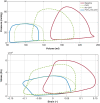How to assess and treat right ventricular electromechanical dyssynchrony in post-repair tetralogy of Fallot: insights from imaging, invasive studies, and computational modelling
- PMID: 38266248
- PMCID: PMC10838147
- DOI: 10.1093/europace/euae024
How to assess and treat right ventricular electromechanical dyssynchrony in post-repair tetralogy of Fallot: insights from imaging, invasive studies, and computational modelling
Abstract
Background and aims: Right bundle branch block (RBBB) and resulting right ventricular (RV) electromechanical discoordination are thought to play a role in the disease process of subpulmonary RV dysfunction that frequently occur post-repair tetralogy of Fallot (ToF). We sought to describe this disease entity, the role of pulmonary re-valvulation, and the potential added value of RV cardiac resynchronization therapy (RV-CRT).
Methods: Two patients with repaired ToF, complete RBBB, pulmonary regurgitation, and significantly decreased RV function underwent echocardiography, cardiac magnetic resonance, and an invasive study to evaluate the potential for RV-CRT as part of the management strategy. The data were used to personalize the CircAdapt model of the human heart and circulation. Resulting Digital Twins were analysed to quantify the relative effects of RV pressure and volume overload and to predict the effect of RV-CRT.
Results: Echocardiography showed components of a classic RV dyssynchrony pattern which could be reversed by RV-CRT during invasive study and resulted in acute improvement in RV systolic function. The Digital Twins confirmed a contribution of electromechanical RV dyssynchrony to RV dysfunction and suggested improvement of RV contraction efficiency after RV-CRT. The one patient who underwent successful permanent RV-CRT as part of the pulmonary re-valvulation procedure carried improvements that were in line with the predictions based on his Digital Twin.
Conclusion: An integrative diagnostic approach to RV dysfunction, including the construction of Digital Twins may help to identify candidates for RV-CRT as part of the lifetime management of ToF and similar congenital heart lesions.
Keywords: Cardiac resynchronization therapy; Digital Twin; Right bundle branch block; Right ventricular dysfunction; Tetralogy of Fallot.
© The Author(s) 2024. Published by Oxford University Press on behalf of the European Society of Cardiology.
Conflict of interest statement
Conflict of interest: J.L. has received research grants from the Dutch Heart Foundation (Dr Dekker programme grant 2015T082) and the Netherlands Organisation for Scientific Research (NWO—ZonMw grant 016.176.340). All remaining authors have declared no conflicts of interest.
Figures





Comment in
-
Computational modelling of cardiac resynchronization therapy in congenital heart disease: fantasy or the future?Europace. 2024 Feb 1;26(2):euae027. doi: 10.1093/europace/euae027. Europace. 2024. PMID: 38266146 Free PMC article. No abstract available.
References
-
- Baumgartner H, Bonhoeffer P, De Groot NM, de Haan F, Deanfield JE, Galie Net al. . ESC guidelines for the management of grown-up congenital heart disease (new version 2010). Eur Heart J 2010;31:2915–57. - PubMed
-
- Yim D, Hui W, Larios G, Dragulescu A, Grosse-Wortmann L, Bijnens Bet al. . Quantification of right ventricular electromechanical dyssynchrony in relation to right ventricular function and clinical outcomes in children with repaired tetralogy of Fallot. J Am Soc Echocardiogr 2018;31:822–30. - PubMed
-
- Vojtovic P, Kucera F, Kubus P, Gebauer R, Matejka T, Tlaskal Tet al. . Acute right ventricular resynchronization improves haemodynamics in children after surgical repair of tetralogy of Fallot. Europace 2018;20:323–8. - PubMed
-
- Janoušek J, Kovanda J, Ložek M, Tomek V, Vojtovič P, Gebauer Ret al. . Pulmonary right ventricular resynchronization in congenital heart disease. Acute improvement in right ventricular mechanics and contraction efficiency. Circ Cardiovasc Imaging 2017;10:e006424. - PubMed
MeSH terms
Grants and funding
LinkOut - more resources
Full Text Sources
Research Materials

